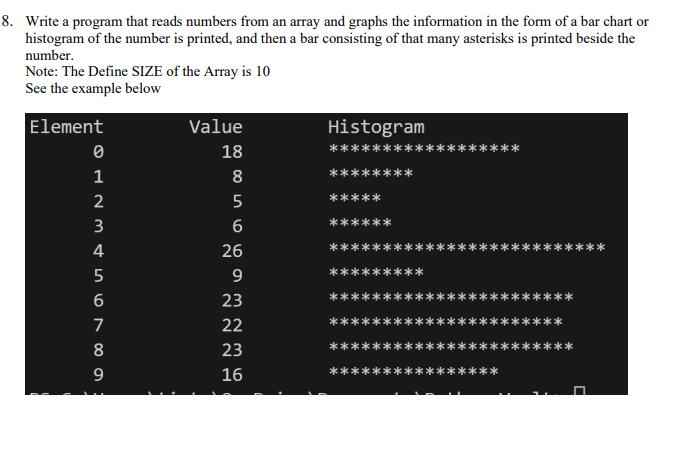
Write a program that reads numbers from an array and graphs the information in the form of a bar chart or histogram. If the number is printed, then a bar consisting of that many asterisks is printed beside the number. Note: The defined size of the array is 10. See the example below. 6. Write a program to determine the maximum height to which a projectile will travel if atmospheric resistance is neglected, for different initial velocities. This problem demonstrates the use of repetition controlle

![6. Write a program to determine the maximum height to which a projectile will travel if atmospheric resistance is neglected, for different initial velocities. This problem demonstrates the use of repetition controlled by a terminating limit. Method: The mass of the projectile is m, the initial velocity is v0 m/sec, the last initial velocity is vft/sec. From equations of motion: w=mg, Fz=maz. Applying these equations for the projectile results in the following equations: mg=mac gives ac=g. Initial conditions: s0=0, v0=v. Final conditions: sf=h, vf=0. From Kinematics: vf2=v02+2ac(sfs0) 0=v2+2ac(h0) 2ach=v2 h=2acv2 Data: Real values of initial velocity at 50, 100, 150, and 200 ft/sec. The real value of gravitational acceleration is 32.2 ft/sec2. 7. Write a program to compute and print a table of torsion shear stresses for circular rods having various torsion loads at various offsets. This problem demonstrates the use of nested repetitions. Data: Diameter: 5 and 6 inches. Load: 1000 and 12,000 pounds. Offset: 10, 15, and 20 L. Method: Let D = diameter of the rod. P = torsion load in pounds. L = offset. The torsion shear stress is given by the formula Ts = D^3/(16PL). 8. Write a program that reads numbers from an array and graphs the information in the form of a bar chart or histogram. The number is printed first, and then a bar consisting of that many asterisks is printed beside the number. Note: The define size of the array is 10. Example: [Number]: ********** [Number]: * [Number]: ********* [Number]: ***** [Number]: ********** [Number]: **** [Number]: ** [Number]: ******* [Number]: ******** [Number]: *******](https://gotit-pro.com/wp-content/uploads/2023/10/6c588a25-0ba0-4cf2-9cb7-5cd4974446e7.png)